|
|
|
;----------
|
The green sea turtle
(Chelonia mydas), or "honu" in Hawaiian, is one of several marine turtles
in Hawaii.
|
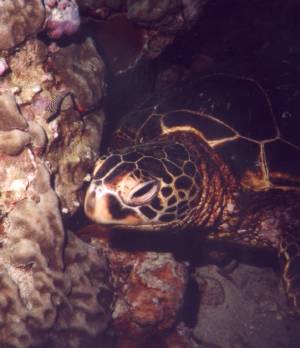
|
;---

|
The green sea turtle
is the most common marine turtle in Hawaii. This is the species most likely to
be seen by snorkellers and divers.
|
;---------
|
Green sea turtles'
diets include certain types of algae (or "seaweed"). These turtles are often
observed "resting" on the ocean floor, often in caves or under overhangs.
Sometimes they aggregate in areas known as "cleaning stations", where fishes &
invertebrates are often observed eating what may be algae growing on the
turtles' backs or parasites which have attached themselves to the
turtles.
|

|
;---
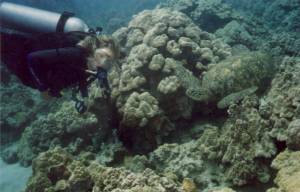
|
Although turtles can
be approached quite closely by divers, this should always be done slowly,
and the diver should stop before it appears to make the turtle the least bit
"uncomfortable", and certainly should back off if the behavior of the turtle
begins to change.
|
;----------
|
Some turtles are very
"friendly"--perhaps curious--and will actually approach divers. Even if a
turtle approaches a diver, the diver should never attempt to touch or
hold on to the turtle (e.g. for a "ride"). Besides being stressful to the
animal--and therefore generally "bad form"--this is illegal. Both state law and
the Federal Endangered Species Act generally prohibit harassing, harming,
killing sea turtles of any kind. "Harassing" includes any activity that causes
a change in behavior of the animal (e.g. "running away" from an approaching
snorkeller or diver). (The turtle in this picture approached and circled 'round
me as I hovered in a stationary position. My sister Laura took this
photo.)
|
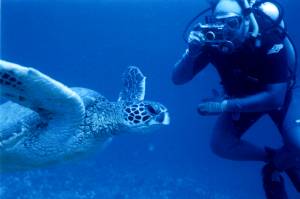
|
;---
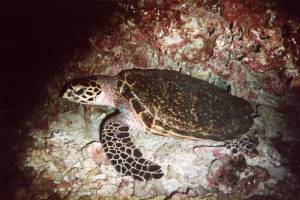
|
The hawksbill
turtle (Eretmochelys imbricata) is another endangered sea turtle,
much rarer than the green sea turtle in Hawaii. Hawksbill shells were
historically used for making "tortoiseshell" combs, brush handles, eyeglass
frames, buttons, hairclips, and jewelry. Additionally, people used to display
"stuffed" baby hawksbills as curiosities. Fortunately, this is a thing of the
past in some countries (e.g. U.S., including Hawaii), since marine turtles
are protected by endangered species laws. Although these practices still occur
in some countries (such as certain Asian countries), fortunately it is illegal
to even bring such products into the United States.
|
;---
|
After a many-years-
long life journey to adulthood (sexual maturity), sea turtles come to land
(sandy beaches) very rarely, and then it's only females, to lay their eggs.
Most (all?) sea turtles return to lay their eggs to the very same beach where
they were hatched, after years and hundreds of miles of travels in the ocean.
It is a mystery how turtles perform this amazing feat of navigation.
|
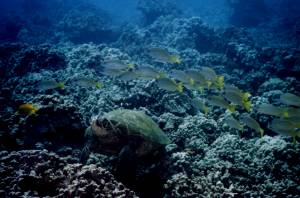
|
;----------
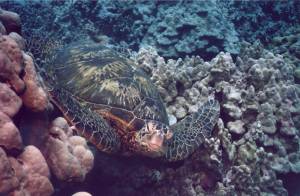
|
Very few baby turtles
survive to adulthood. As soon as they hatch, the tiny turtles scurry to the
ocean & swim into the surf, if they are not eaten by seabirds or other predators
on the way. Then, they face being eaten by any number of marine predators.
Many of the problems marine turtle eggs & hatchlings face today are directly or
indirectly human-related. Even before the eggs are hatched, there are many
hurdles to overcome. Man-introduced dogs, rats--and even humans themselves--
raid turtle nests to eat the eggs. Beachgoing vehicles (ORVs, motorcycles,
beach buggies). Upon hatching, baby turtles may go the wrong direction (instead
of directly to the ocean) by following bright lights which line many beachfront
areas today. These turtles, of course, are almost certainly doomed to
die.
|
;----------
|
Even though marine
turtles are theoretically protected by law, many are still killed by trawling
nets from fishing boats, fishing practices such as "longlining" (unfortunately
still legal), and strangulation by or ingestion of plastics (like the plastic
"six-pack" holders for drink cans).
|
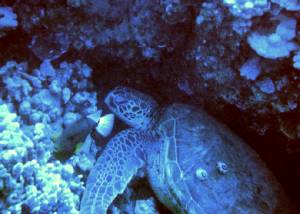
|
;---
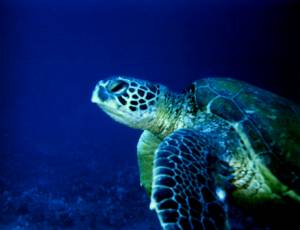
|
Fortunately, it's not
all bad news. Although hunting of turtles prior to enaction of endangered
species reduced their numbers drastically, at least some species are making slow
comebacks in Hawaii. So, please be aware of the "little things" you can do to
help: dispose of plastics properly, and don't chase or touch turtles if you
have the opportunity to visit them! Remember, YOU are the guest in THEIR ocean
home!
|
|